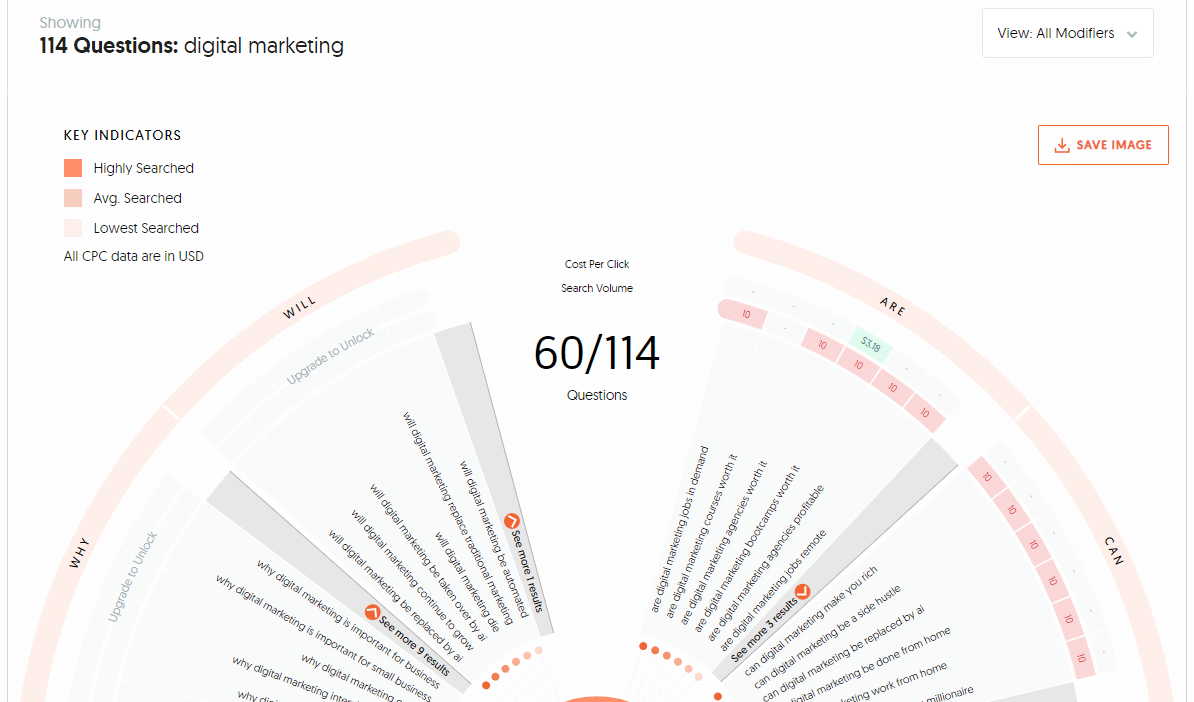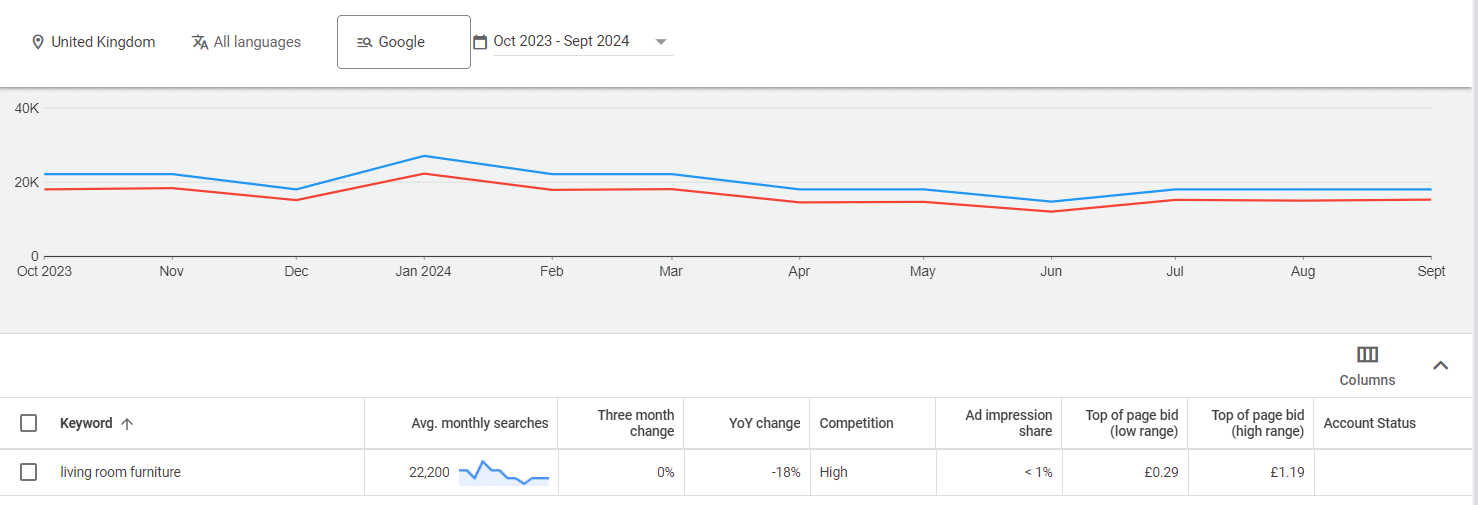
Keyword research is the foundation of any successful PPC campaign. By identifying the right keywords, advertisers can reach their target audience, maximize ad relevance and control costs.
This guide covers everything you need to know about keyword research in PPC – from understanding match types to using tools and refining your keyword strategy for optimal ad performance.
What is keyword research in PPC?
Keyword research involves creating a list of keywords searchers use to find information on a specific topic. It also includes gathering insights into each term’s search volume and, depending on the tool used, the level of competition.
Over time, PPC keyword research has evolved, with Google introducing automation, broader match types and campaign consolidation. These changes have shifted how PPC marketers approach keyword research and the factors they must consider.
Beyond search campaigns, keyword research can also help build audiences for display and video ads. Marketers can expand their reach across multiple ad formats by targeting users who are either searching for specific terms or engaging with content related to those keywords.
Types of keywords
In search advertising platforms like Google Ads and Microsoft Ads, there are four types of keywords, known as match types.
These match types determine how closely the keywords you choose align with a user’s search query, affecting when and how your ads appear.
The match types are divided into positive and negative categories, each with its own level of specificity and reach.
Broad match
- These keywords will match to searches related to the keyword, but the user’s search doesn’t necessarily have to contain the keyword.
- You should use broad match sparingly as it has the most reach and it should always be used in conjunction with smart bidding.
- My recommendation would be to introduce broad match as an experiment once your account has some data behind it.
Phrase match
- These keywords will match to searches that contain the keyword meaning. This means that the user’s search will contain a variation or synonym of the seed keyword.
- Use phrase match for seed keywords that are between one to three keywords long. Google will then expand on this to relevant searches that mean the same.
Exact match
- These keywords will match to user’s searches that share the same meaning. This means that the user’s search could contain a variation or synonym of the seed keyword, the same as phrase match. For example Google would see ‘near’ as having the same intent and meaning as ‘close by’.
- Use exact match in support of phrase match for longer-tail specific keywords.
Below is an example of how Google could use the three positive match types if the seed keyword is “garden furniture.”

Negative keywords
- These keywords prevent ads from showing for irrelevant searches.
- They help reduce wasted ad spend by blocking specific terms.
Choosing the right keywords for your PPC campaigns
Keyword research is one core element of PPC that overlaps with SEO. The teams can collaborate on this in multiple ways, from utilizing the same tools to thinking more strategically around keyword gap analysis.
When it comes to determining which are the right keywords to target, you need to consider:
- The product and/or service offering.
- Your campaign objective and goals.
- What funnel stage the user is at.
- Competitor activity.
- Suitability for advertising (e.g., price point).
- Associated costs and marketing budgets.
- Your target audience.
- Your organic rankings.
Keywords can be broken into key overarching themes:
- Brand terms: Directly related to your own brand (e.g., JD Sports).
- Competitor terms: Your direct competitors’ brand names (e.g., Footasylum).
- Third-party brand terms: Connected to brands you sell (e.g., Nike).
- Generic product category terms: Connected to your product or service offering (e.g., running shoes).
- Generic product-specific terms: Specific product models/types (e.g., Nike Invincible 3).
- Related top-of-funnel terms: Relevant to the user’s challenge (e.g., What are the best running shoes?).
How to conduct keyword research for PPC
Step 1: Identify seed keywords
Your list of seed keywords is there as a starting point to prompt the keyword research tools in the right direction. Your seed keywords are usually broader, 1-3 words in length.
To determine your seed keywords, you must first identify:
- The products and/or services you will be promoting: Will you be promoting your whole offering, or are there certain areas in which you wish to focus? This can depend on budget availability, competitiveness in different areas and price points/margins for different products/services.
- The objectives/goals of the campaigns you will run: Are you focusing purely on the bottom of the funnel where users show high intent and are ready to convert? Or will you also target the top of the funnel where users are just starting their journey, and will your focus be on awareness and consideration?
Step 2: Use keyword research tools to expand your seed list
When it comes to keyword research, well-known and lesser-known tools can help you build your target keyword list. Here are some of the tools I frequently use:
- Google Keyword Planner tool, a free tool built into Google Ads, offers suggestions of keywords based on up to 10 base keywords you input or a website URL. For the website URL, you can use both your own and that of your competitors if they have better website content.

- AnswerThePublic offers up to three free searches per day, but you can also sign up for their premium subscription. The tool is great for finding top-of-funnel searches as it looks at questions, prepositions and comparisons such as who, what and how.

- Semrush (disclosure: Semrush owns Search Engine Land) can be used for SEO analysis, competitor analysis and keyword research.
- Google autocomplete can give you insight into which terms for a given topic are trending and popular. To activate this, just start typing a search into Google.
- ChatGPT can help you expand on initial seed keywords. You can ask the tool to give you back a specific number of keywords or focus on specific types of terms.
Dig deeper: 19 keyword mining tools and strategies for PPC campaign growth
Step 3: Analyze keyword metrics
Another important element of keyword research is analyzing the metrics to determine the search volume, competition levels and PPC expectations.

Step 4: Review SEO keywords
Liaise with the SEO team to share existing keyword lists.
This can reduce task duplication and help you identify where website content may be optimized for certain terms, improving your quality score.
Review the existing keywords in use for SEO purposes to identify any gaps.
Dig deeper: Top 7 Google Ads and SEO synergies you should act upon
Structuring your keywords
Once you have your list of keywords, the next step is to structure them into groupings based on themes.
There are a couple of options for structuring your keywords, and which is most logical will depend on your business and the objectives you identified earlier.
Keywords will typically be grouped by one of the following:
- Overarching theme.
- Product categories.
- Service categories.
- Search intent.
Ad group structure is important because this is where your ad copy will be set.
Google ranks your ads based on quality scores to determine whether they show up in a user’s search, so you must build well-structured ad groups.
One factor of the quality score is ad relevance, so you need to ensure that your keywords align with your ad. This is only possible when keywords are grouped logically together based on shared themes.
Refining your keywords
One key change in Google’s new approach to match types is the increase in redundant keywords.
This happens because both phrase and exact match go beyond just the keywords you input to find searches of the same meaning.
This change in search term matching means that, instead of needing both variations and a large keyword list, you only need a smaller set of keywords that cover all angles.
When deciding which keywords are redundant, you should consider:
- Is the keyword intent the same as another keyword in your list? If it is, which keyword reads the most naturally?
- Would the keyword benefit from having a unique ad? For example, while garden furniture may also trigger rattan furniture, this particular search may benefit from having a unique ad and landing page specifically around rattan furniture rather than garden furniture in general.
- If you remove a keyword, will other keywords you have likely trigger an ad?
- Does the keyword have a reasonable search volume? Keywords with 10 searches a month are likely to sit in the account as low-search volume keywords.
In addition to removing redundant keywords, you will also want to refine your keyword selection based on:
- Keyword relevancy.
- Budget availability. Prioritize high-intent keywords.
- Organize your keywords into relevant groups based on the keyword theme.
Best practices for PPC keyword research
Follow these best practices to streamline your process, target the right audience and reduce ad spend inefficiencies.
- Focus on long-tail keywords: This helps to improve your targeting and ad relevance and lower your CPCs.
- Use negative keywords: A good practice is to build themed negative keyword lists and apply these across multiple campaigns.
- Select keywords based on metrics: Balance having enough search volume within your keywords with the level of competition, always ensuring relevancy. I avoid keywords with less than 50 monthly searches unless they are in niche categories.
- Review keywords regularly: Check and update your keyword list based on performance and upcoming trends.
Common mistakes to avoid
To ensure your keyword research delivers the best results, steer clear of the following pitfalls.
- Overreliance on broad match: Avoid relying too much on broad match terms. While they can help find keyword growth opportunities, they don’t let you customize ads as much as phrase and exact match terms do.
- Lack of negatives: Negatives are there to block irrelevant searches, but they can also be used to guide Google to show a specific ad, particularly if you have broad match keywords in use as well.
- Not expanding after launch: While you will get a good base set of keywords at launch, there is continued room for expansion.
- Large ad groups: If an ad group contains 15+ keywords, it’s often a good indication that either the ad group theme is not tight enough or you have a high volume of redundant keywords.
Build a strong foundation for your PPC efforts
Keyword research is a crucial part of any successful PPC campaign.
By following best practices, avoiding common mistakes and refining your keyword strategy, you can improve ad targeting, reduce wasted spend and maximize ROI.
Effective keyword research enhances your search campaigns and strengthens your overall advertising efforts.
https://searchengineland.com/ppc-keyword-research-448061